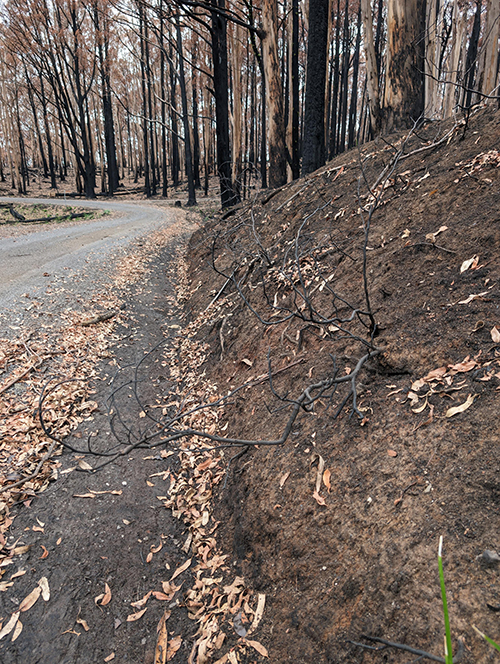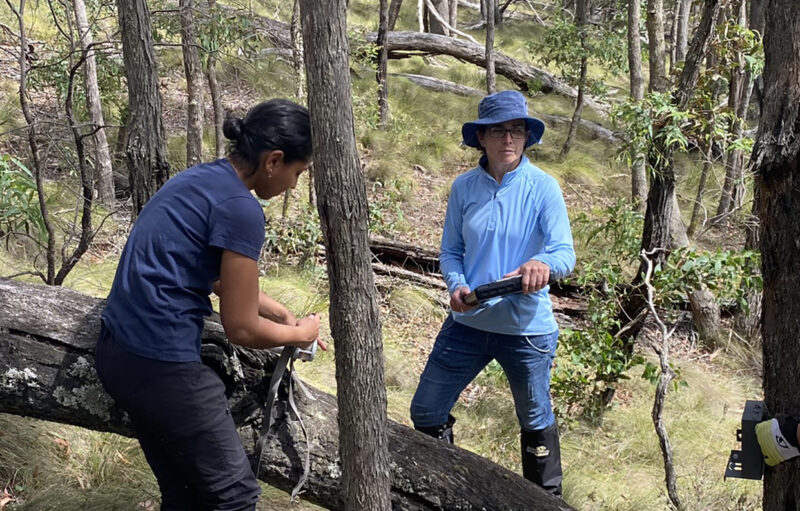PARK WATCH Article June 2024 |
There is a very real possibility that this beautiful and unique flowering plant will face extinction in the wild unless we properly resource and prioritise a recovery plan, says Ben Gill, Nature Conservation Campaigner
Recent fires at much loved Mt Cole/Bereep Bereep have severely impacted the homes and habitats of several threatened plants and animals, including the Critically Endangered Mt Cole Grevillea (Grevillea monits cole).
These stunning forests, rising up on an extinct volcano surrounded by blankets of farmland, feature 16 unique habitat types (known as ecological vegetation classes) that support an array of wonderful critters and plant life.
It’s vital that, after the devastating fires devoured 95 per cent of greater Mt Cole, a properly funded recovery plan is carried out for this popular future national park.
The southern end resembles the tree fern-clad valleys and mountainsides of the Dandenongs, whilst one of the state’s most westerly populations of Snow Gums lay twisted and hunkered into the mountain tops amongst the granite boulders. The northern end near the Pyrenees are drier open forests. The unique terrain provides haven and habitat for threatened plants and animals like Brush-tailed Phascogales, Grampians Bitter Peas and Mountain Brush-tailed Possums.
Potential extinction
Mt Cole is home to the eponymously named Mt Cole Grevillea, found nowhere else on earth. After these fires, there’s a devastatingly high chance this endemic red flowering beauty may become extinct in the wild. The fire caused the near entire loss of the understorey layer, impacting 100 per cent of known records within the study area.
The decline in extent or potential extinction of the Mt Cole Grevillea is a significant risk due to the loss of the understorey layer. It regenerates from seed stored in the soil following fire, but seed longevity is unknown. The Mt Cole Grevillea reaches sexual maturity after three years, with a generation length estimated to be somewhere between 30 to 70 years.
In 2019, following a nomination from VNPA, the Scientific Advisory Committee assessed the Mt Cole Grevillea and recommended it be listed on the Flora and Fauna Guarantee Act. It was currently listed as Critically Endangered, the last step before extinction in the wild.
For many years, VNPA has advocated for the creation of the Mt Cole-Buangor National Park to formalise the plant’s protection and limit the impacts of threats like inappropriate fire regimes and logging.
The Mt Cole Grevillea is also vulnerable to browsing by various herbivores. Estimates put the plant’s decline in recent decades at 75 per cent, with a reduction in its range from 2570 hectares to a mere 700 hectares before last Summer’s fires.
The Royal Botanic Gardens Victoria holds three living Mt Cole Grevillea specimens, with 220 seeds available for reseeding in the event of widespread in-situ recruitment failure.
A day of horror
Thursday 22 February 2024 was a day of total fire ban. I was alerted by a local environment group member and watched in horror as the scale of the fire grew, huge pyrocumulus clouds hinting at the ferocity of the fire beneath it. The fire burned for seven days until it ran out of fuel, having consumed nearly all of Mt Cole’s forest. The next day I wept as I reviewed the satellite imagery, and the impacts became clear. There was barely a valley or safe haven for the creatures of the forest that remained.
VNPA were contacted by Department of Energy, Environment and Climate Action (DEECA) Rapid Response Assessment Team. It felt good to work constructively with a government department toward a shared goal of identifying the issues faced for Mt Cole’s biodiversity recovery. DEECA adopted many of our recommendations into their final report that will become the basis for a funding bid. But now comes the hard part – finding the resources for the gamut of urgent work necessary to help this wonderful forest return to its past grandeur.
Millions of dollars were provided for recovery after the 2019/2020 fires in East Gippsland, setting a new benchmark. Whilst not of the same scale, the severity of the fires at Mt Cole requires urgent investment.
VNPA undertook our own recovery report to feed into the State Government’s response. We covered key themes such as threatened species recovery; monitoring of the fen or bog; impacts on important regional plants such as the Snow and Yarra gum populations; mapping burn impacts and severity; invasive species control; pathogen control and exclusion of heavy machinery to minimise chance of spread of Phtopthora or Armillaria; visitor and park infrastructure such as the popular Beeripmo Walk; and finally legislating the promised parks to cement the protections.
Salvage logging underway
It’s now four months since the forest was closed to the public. With that exclusion comes a concern that some form of salvage logging is taking precedent over preventing the likely extinction of an endemic and truly unique plant.
Post-fire photos of known Mt Cole Grevillea show one lone burnt stem that still stands, forlorn, on an embankment. Mere months ago the same patch was flush with a healthy population In recent years, we’d found several baby plants just starting to become big enough to survive grazing by feral deer. We’ve yet to see decisive actions, like fencing-off of known areas to prevent the threat of fresh young regrowth from grazing by herbivores.
Holding Council to account
Recently, VNPA was contacted by locals horrified that Pyrenees Shire was heavy-handedly removing nearly all roadside trees in the rural living zone around the base of the mountain.
It was a tough drive through the devastation. Nearly every tree glinted with a silver aluminium tag – its fate sealed by an over-zealous arborist who appears to underestimate the resilience of our mixed species trees to recover from fire.
A tight-knit group of dedicated locals has leapt into action. They questioned arborist assessments and argued against the mindless cutting down of many trees that would have otherwise recovered.
So far, they’ve reduced the removals to trees that pose an immediate risk to road users. It’s a sad day when locals have to offer to assess trees and give days and weeks of their time to protect not only the homes of surviving creatures, but an essential part of the forest’s recovery.
At the cost of just one of 110 rail crossing removals planned for Melbourne, we could save many plants and animals, including Mt Cole Grevillea. I know I’d be fine waiting a few minutes at a rail crossing if it meant that I could show my son the beauty of the Mt Cole Grevillea.
- Read the latest full edition of Park Watch magazine
- Subscribe to keep up-to-date about this and other nature issues in Victoria
- Become a member to receive Park Watch magazine in print

